1993 CADILLAC SEVILLE turn signal
[x] Cancel search: turn signalPage 187 of 407
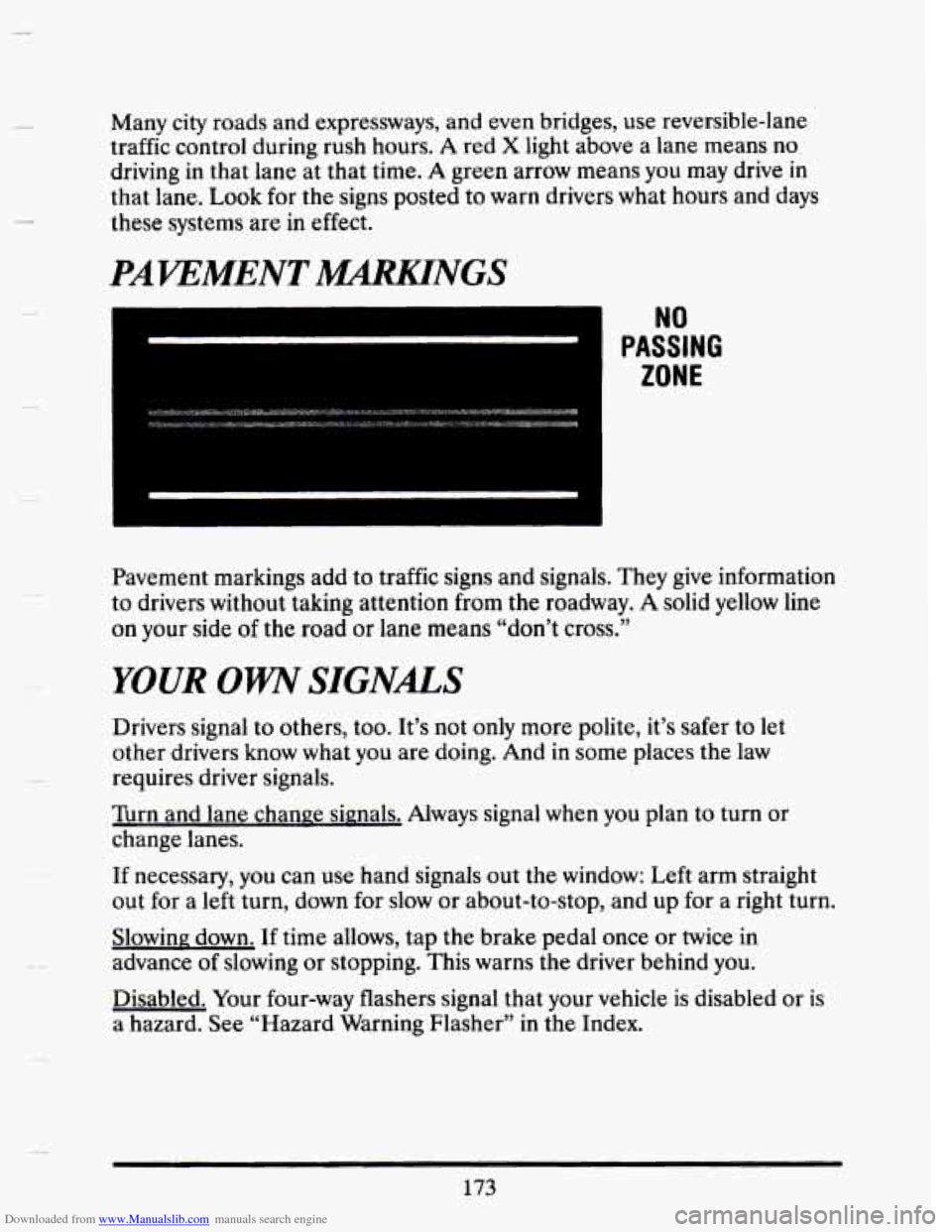
Downloaded from www.Manualslib.com manuals search engine Many city roads and expressways, and even bridges, use reversible-lane
traffic control during rush hours.
A red X light above a lane means no
driving in that lane at that time.
A green arrow means you may drive in
that lane. Look for the signs posted to warn drivers what hours and days
these systems are in effect.
PAKEMENTlMARKlNGS
NO
PASSING
1 ZONE
Pavement markings add to traffic signs and signals. They give information
to drivers without taking attention
from the roadway. A solid yellow line
on
your side of the road or lane means “don’t cross.’’
YOUR OWN SIGNALS
Drivers signal to others, too. It’s not only more polite, it’s safer to let
other drivers know what you are doing.
And in some places the law
requires driver signals.
Turn and lane change signals. Always signal when you plan to turn or
change lanes.
If necessary,
you can use hand signals out the window: Left arm straight
out for
a left turn, down for slow or about-to-stop, and up for a right turn.
Slowing down. If time allows, tap the brake pedal once
or twice in
advance
of slowing or stopping. This warns the driver behind you.
Disabled. Your four-way flashers signal that your vehicle
is disabled or is
a hazard. See “Hazard Warning Flasher” in the Index.
173
Page 188 of 407
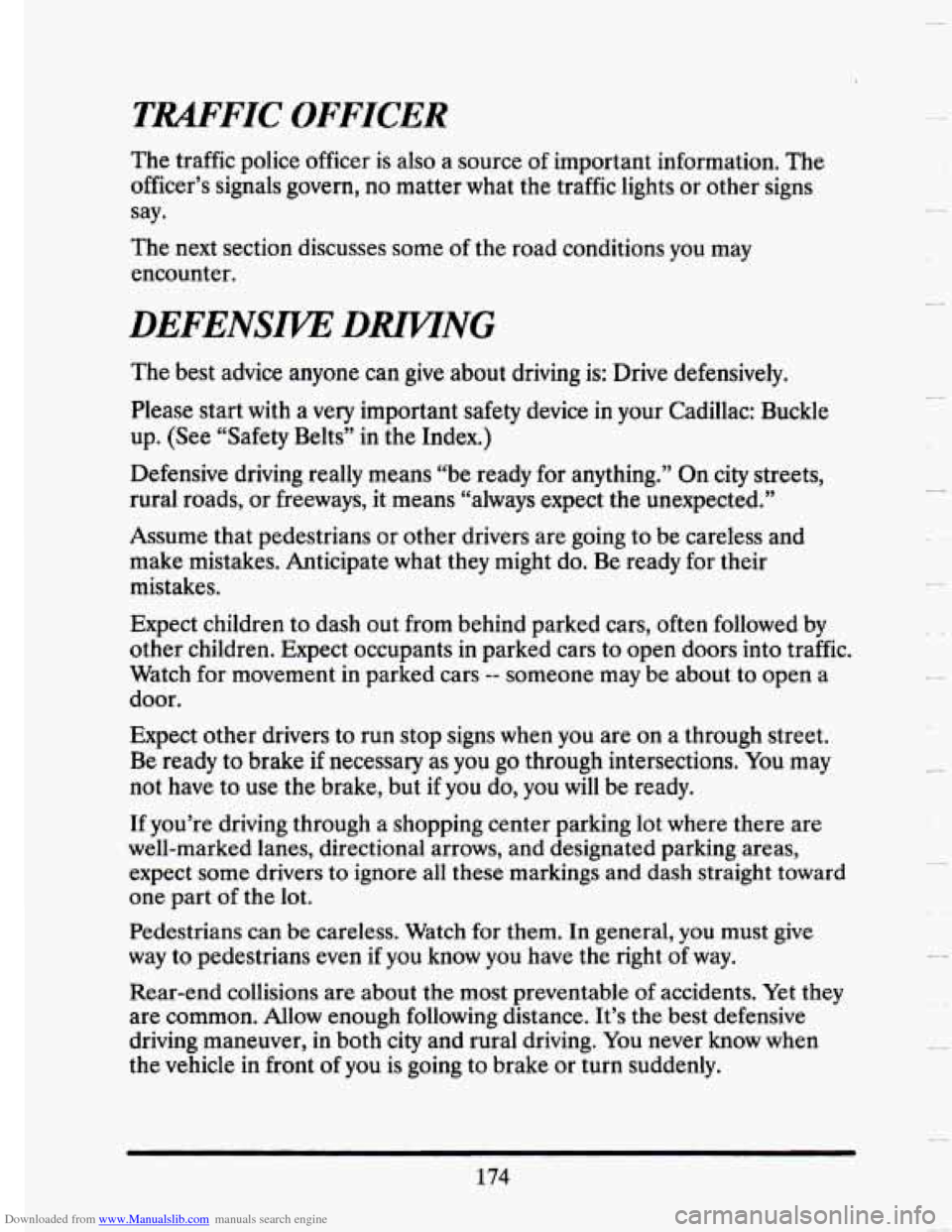
Downloaded from www.Manualslib.com manuals search engine TRAFFIC OFFICER
The traffic police officer is also a source of important information. The
officer’s signals govern, no matter what the traffic
lights or other signs
say.
The next section discusses some
of the road conditions you may
encounter.
DEFENSm DmNG
The best advice anyone can give about driving is: Drive defens\
ively.
Please start with a
very important safety device in your Cadillac: Buckle
up. (See “Safety Belts” in the Index.)
Defensive driving really means “be ready for anything.” On\
city streets,
rural roads, or freeways, it means “always expect the unexpected.”
Assume that pedestrians or other drivers are going to be careless and
make mistakes. Anticipate what they might do.
Be ready for their
mistakes.
Expect children to dash out from behind parked cars, often followed by
other children. Expect occupants
in parked cars to open doors into traffic.
Watch for movement in parked cars
-- someone may be about to open a
door.
Expect other drivers to run stop signs when you are on
a through street.
Be ready to brake if necessary as you go through intersections.
You may
not have to use the brake, but if you do, you will be ready.
If you’re driving through a shopping center parking lot where mere are
well-marked lanes, directional arrows, and designated parking are\
as,
expect some drivers to ignore all these markings and dash straight toward
one part
of the lot.
Pedestrians can be careless. Watch for them. In general, you must give
way to pedestrians even
if you know you have the right of way.
Rear-end collisions are about the most preventable of accidents. Yet
they
are common. Allow enough following distance. It’s the best defensive
driving maneuver,
in both city and rural driving. You never know when
the vehicle in front of you is going to brake or turn suddenly.
u
c
Page 202 of 407

Downloaded from www.Manualslib.com manuals search engine lane as oncoming traffic for several seconds. A miscalculation, an error in
judgment, or a brief surrender to frustration or anger can suddenly put
the passing driver face to face
with the worst of all traffic accidents -- the
head-on collision.
So here are some tips for passing:
0
0
0
0
a
“Drive ahead.” Look down the road, to the sides, and to crossroads
for situations that might affect your passing patterns.
If you have any
doubt whatsoever about making
a successful pass, wait for a better
time.
Watch
for traffic signs, pavement markings, and lines. If you can see a
sign up ahead that might indicate a turn or an intersection, delay your
pass.
A broken center line usually indicates it’s all right to pass
(providing the road ahead is clear). Never cross a solid line on your
side of the lane or a double solid line, even
if the road seems empty of
approaching traffic.
If you suspect that the driver of the vehicle you want
to pass isn’t
aware
of your presence, tap the horn a couple of times before passing.
Do not get too close to the vehicle you want to pass while you’re
awaiting an opportunity.
For one thing, following too closely reduces
your area of vision, especially
if you’re following a larger vehicle. Also,
you won’t have adequate space if the vehicle ahead suddenly slows or
stops. Keep back a reasonable distance.
When it looks like a chance to pass
is coming up, start to accelerate
but stay in the right lane and don’t get too close. Time your move so
you will be increasing speed as the time comes to move into the other
lane.
If the way is clear to pass, you will have a “running start” that
more than makes up for the distance you would
lose by dropping back.
And if something happens to cause you to cancel your pass, you need
only slow down and drop back again and wait for another opportunity.
If other cars are lined up to pass a slow vehicle, wait your turn. But
take care that someone isn’t trying to pass
you as you pull out to pass
the
slow vehicle. Remember to glance over your shoulder and check
the blind spot.
Check your mirrors
, glance over your shoulder, and start your left
lane change signal before moving out of the right lane to pass. When
you are far enough ahead of the passed vehicle to see its front in your
188
H
-.-
rc
Page 203 of 407
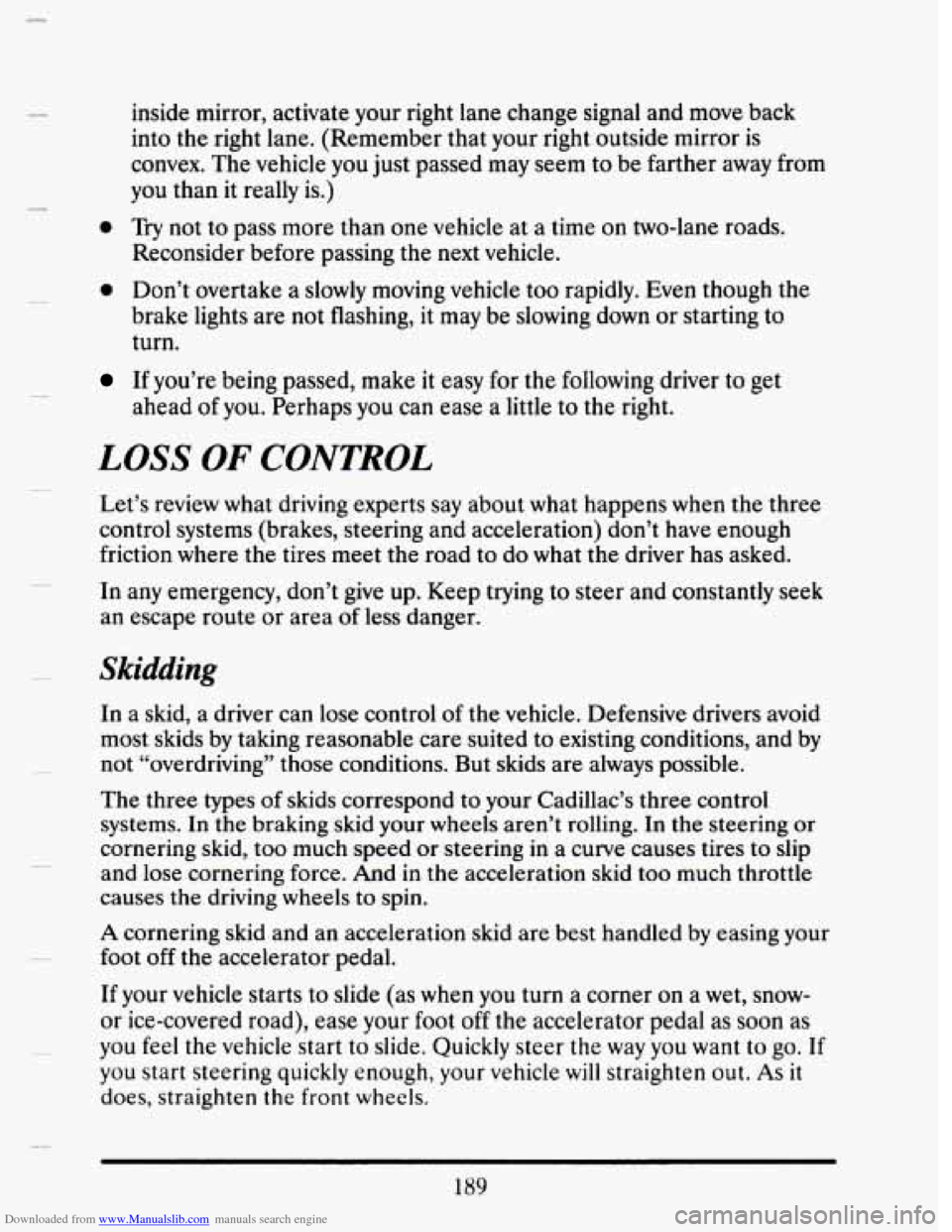
Downloaded from www.Manualslib.com manuals search engine inside mirror, activate your right lane change signal and move back
into the right lane. (Remember that your right outside mirror is
convex. The vehicle you just passed may seem
to be farther away from
you than it really is.)
0 Try not to pass more than one vehicle at a time on two-lane roads.
Reconsider before passing
the next vehicle.
0 Don’t overtake a slowly moving vehicle too rapidly. Even though the
brake lights are not flashing,
it may be slowing down or starting to
turn.
If you’re being passed, make it easy for the following driver to get
ahead
of you. Perhaps you can ease a little to the right.
LOSS OF CONTROL
Let’s review what driving experts say about what happens when the three
control systems (brakes, steering and acceleration) don’t have enough
friction where the tires
meet the road to do what the driver has asked.
In any emergency, don’t give up. Keep trying to steer and constantly
seek
an escape route or area of less danger.
Skidding
In a skid, a driver can lose control of the vehicle. Defensive drivers avoid
most skids by taking reasonable care suited to existing conditions, and by
not “overdriving” those conditions. But skids are always possible.
The three types of skids correspond to your Cadillac’s three control
systems. In the braking skid your
wheels aren’t rolling. In the steering or
cornering skid, too much speed or steering
in a curve causes tires to slip
and lose cornering force. And
in the acceleration skid too much throttle
causes
the driving wheels to spin.
A cornering skid and an acceleration skid are best handled by easing your
foot
off the accelerator pedal.
If your vehicle starts to slide (as when you turn a corner on a wet, snow-
or ice-covered road), ease your foot
off the accelerator pedal as soon as
you feel
the vehicle start to slide. Quickly steer the way you want to go. If
you start steering quickly enough, your vehicle will straighten out. As it
does, straighten the front wheels.
189
Page 206 of 407
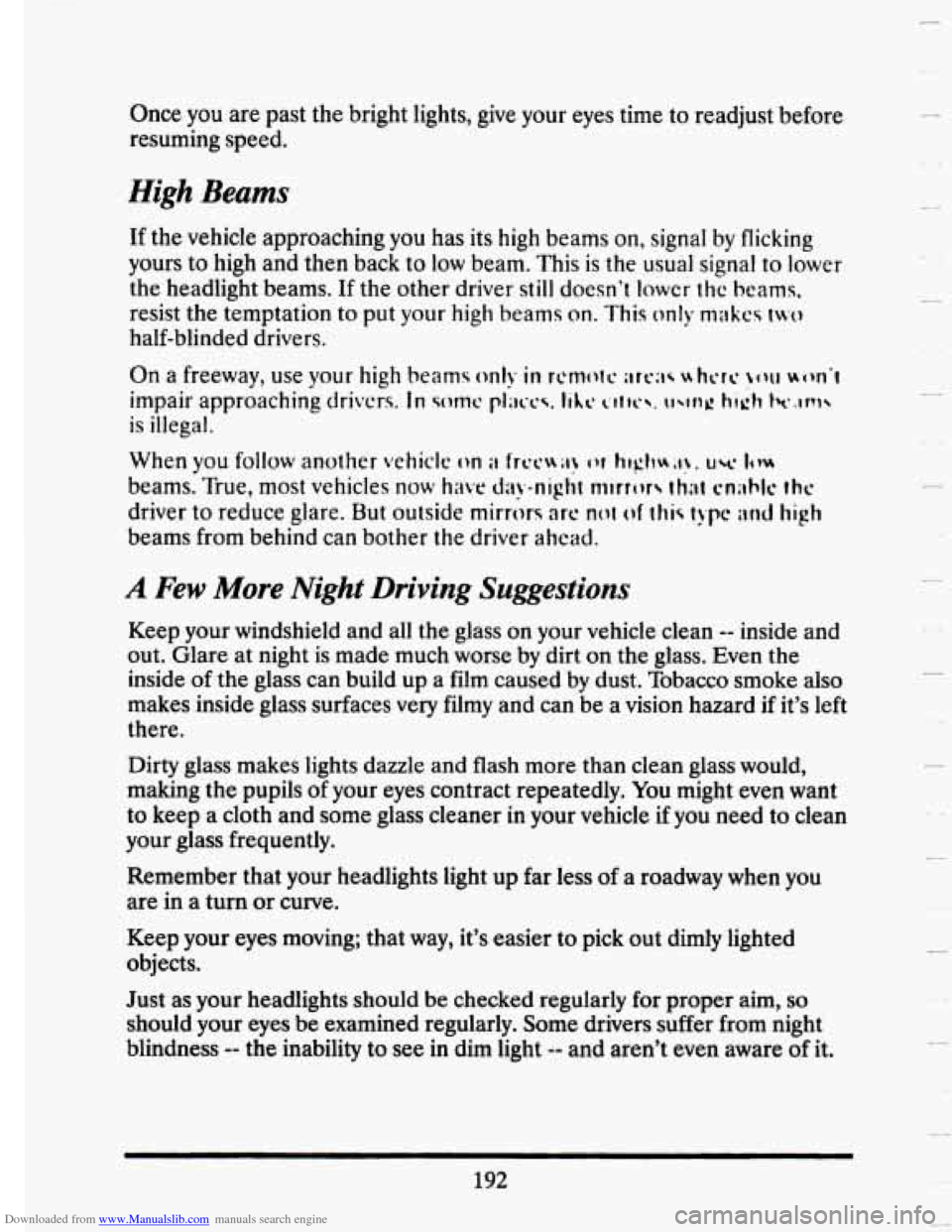
Downloaded from www.Manualslib.com manuals search engine Once YOU are past the bright lights, give your eyes time to readjust before
resuming speed.
High Beams
If the vehicle approaching you has its high beams on, signal by flicking
yours to high and
then back to low beam. This is the usual signal to lower
the headlight beams. If the other driver still doesn't lowcr thc beams,
resist the temptation to put your high beams on. This only makcs two
half-blinded drivers.
When you follow another
vehiclc on ii Irt'CHiI! or h1gh;n. uw I(VH
beams. True, most vehicles now have d;wnight mirror that cn;rblc rhc
driver to reduce glare. But outside mirrbrs arc' not of thi< typc i\d high
beams from behind can bother the driver ahcad.
A Few More Night Driving Suggestions
Keep your windshield and all the glass on your vehicle clean -- inside and
out. Glare at night is made much worse
by dirt on the glass. Even the
inside
of the glass can build up a film caused by dust. Tobacco smoke also
makes inside glass surfaces
very filmy and can be a vision hazard if it's left
there.
Dirty glass makes lights dazzle and flash more than clean glass would,
making the pupils
of your eyes contract repeatedly. You might even want
to keep a cloth and some glass cleaner
in your vehicle if you need to clean
your glass frequently.
Remember that your headlights light up far less
of a roadway when you
are in
a turn or curve.
Keep your eyes moving; that way, it's easier to pick out dimly lighted
objects.
Just as your headlights should be checked regularly for proper aim, so
should your eyes be examined regularly. Some drivers suffer from night
blindness
-- the inability to see in dim light -- and aren't even aware of it,
192
Page 207 of 407
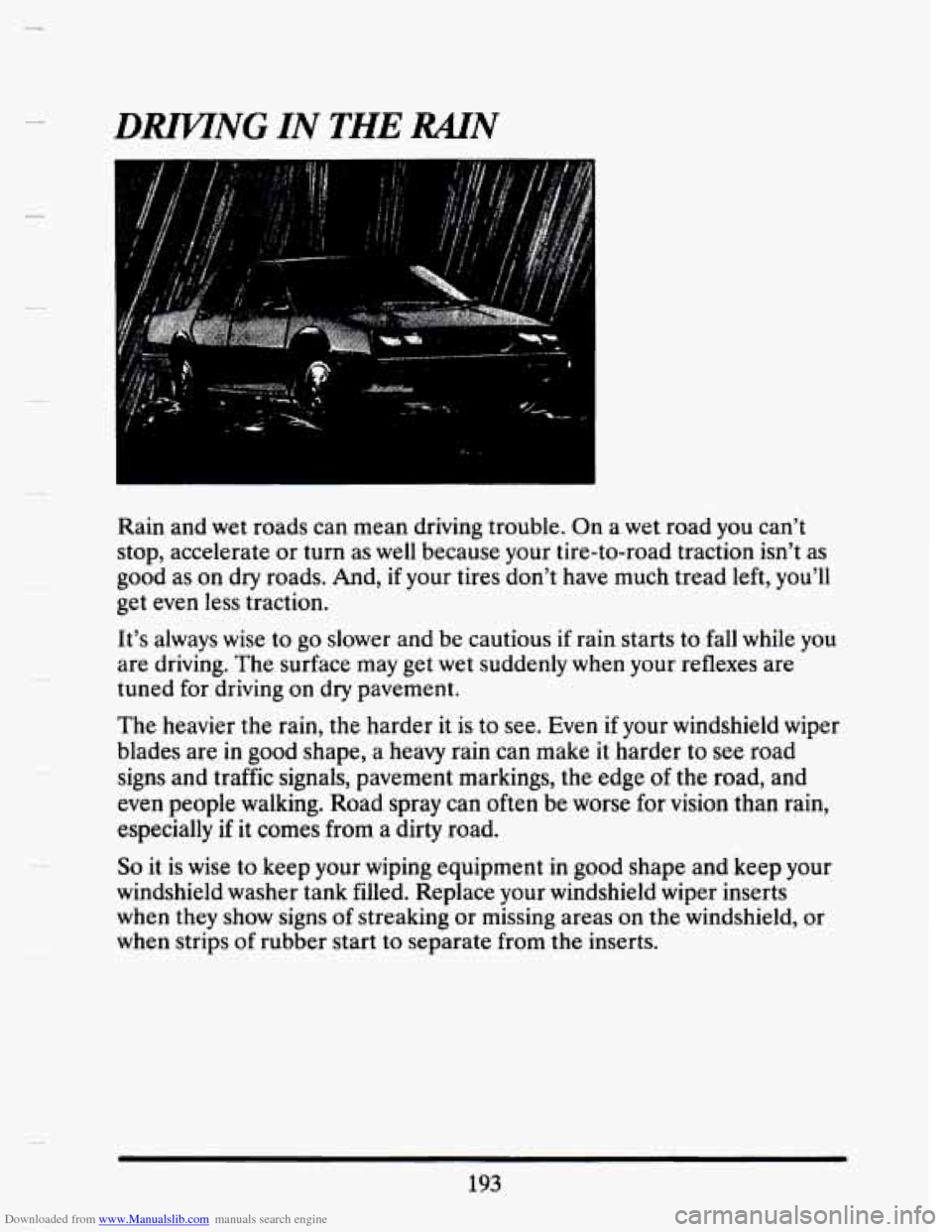
Downloaded from www.Manualslib.com manuals search engine DmNG IN THE RAIN
Rain and wet roads can mean driving trouble. On a w et road ya IU can’t
stop, accelerate or turn as well because your tire-to-road traction isn’t as
good as on dry roads. And,
if your tires don’t have much tread left, you’ll
get even less traction.
It’s always wise
to go slower and be cautious if rain starts to fall while you
are driving. The surface may get wet suddenly when your reflexes are
tuned for driving
on dry pavement.
The heavier the rain, the harder it is to see. Even if your windshield wiper
blades are
in good shape, a heavy rain can make it harder to see road
signs and traffic signals, pavement markings, the edge
of the road, and
even people walking. Road spray can often be worse for vision than rain,
especially if it comes from a dirty road.
So it is wise to keep your wiping equipment in good shape and keep your
windshield washer tank filled. Replace your windshield wiper inserts
when they show signs of streaking or missing areas on the windshield, or
when strips
of rubber start to separate from the inserts.
193
Page 212 of 407
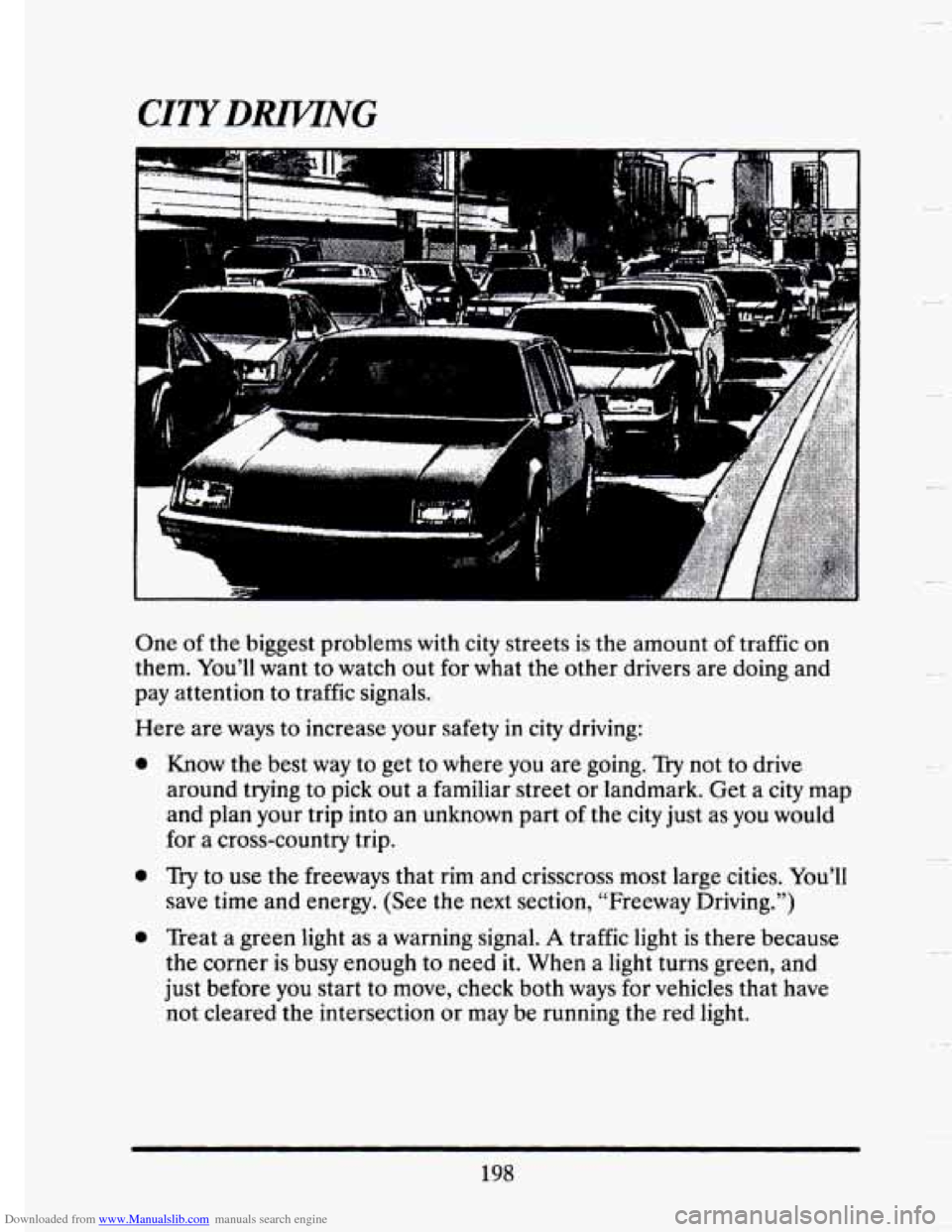
Downloaded from www.Manualslib.com manuals search engine CIZYDRlWNG
One of the biggest problems with city streets is the amount of traffic on
them. You’ll want to watch out for what the other drivers are doing and
pay attention to traffic signals.
Here are ways to increase your safety
in city driving:
a
a
0
Know the best way to get to where you are going. Try not to drive
around trying to pick out a familiar street or landmark. Get a
city map
and plan your trip into
an unknown part of the city just as you would
for a cross-country trip.
Try to use the freeways that rim and crisscross most large cities. You’ll
save time and energy. (See the next section, “Freeway Driving.”)
Treat a green light as a warning signal.
A traffic light is there because
the corner
is busy enough to need it. When a light turns green, and
just before you start to move, check both ways for vehicles that have
not cleared the intersection or may be running the red light.
198
Page 213 of 407
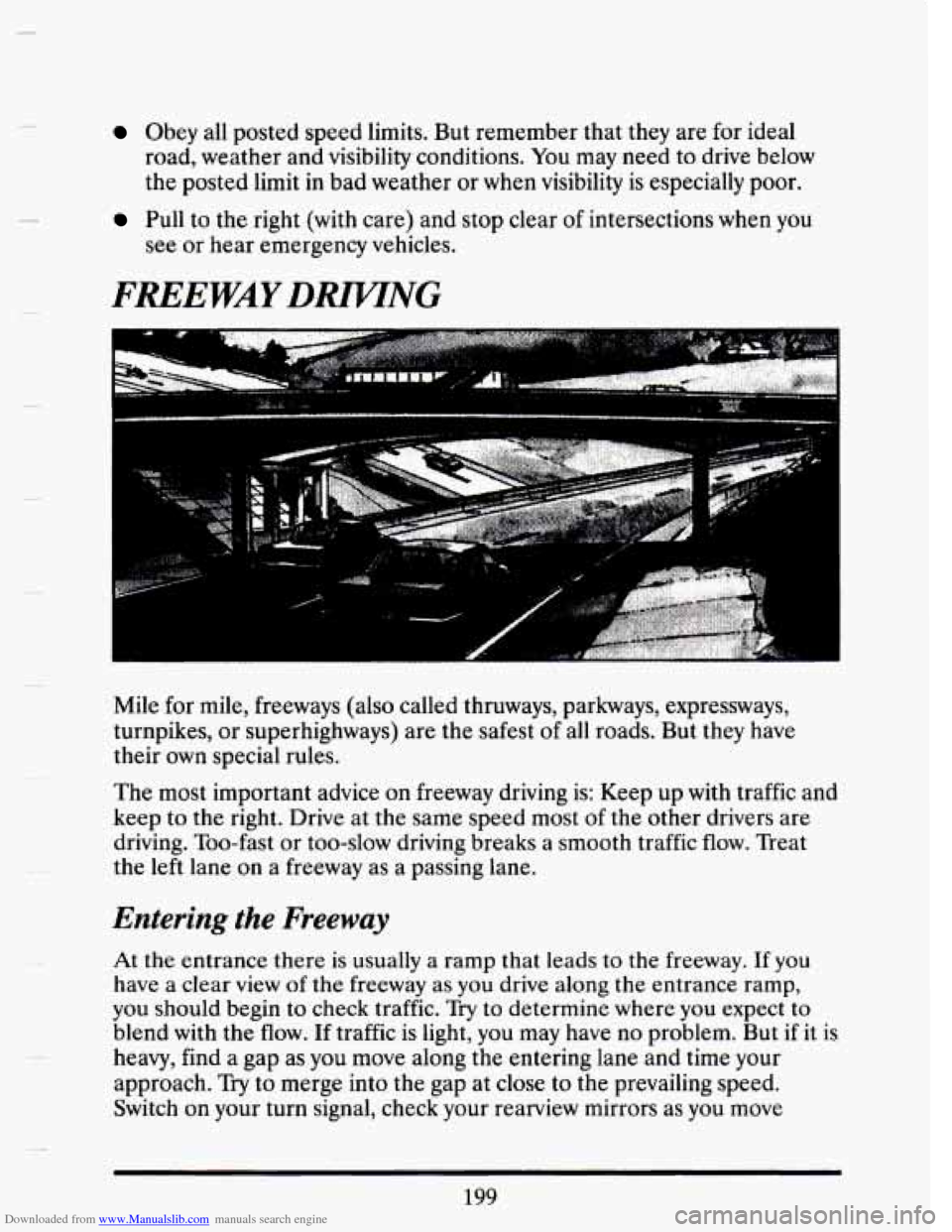
Downloaded from www.Manualslib.com manuals search engine Obey all posted speed limits. But remember that they are for ideal
road, weather and visibility conditions.
You may need to drive below
the posted limit in bad weather or when visibility
is especially poor.
Pull to the right (with care) and stop clear of intersections when you
see or hear emergency vehicles.
FREEWAY DMNG
Mile for mile, freeways (also called thruways, parkways, expressways,
turnpikes, or superhighways) are the safest
of all roads. But they have
their own special rules.
The most important advice on freeway driving is: Keep up with traffic and
keep to the right. Drive at the same speed most
of the other drivers are
driving. Too-fast or too-slow driving breaks a smooth traffic
flow. Treat
the left lane on a freeway as a passing lane.
Entering the Freeway
At the entrance there is usually a ramp that leads to the freeway. If you
have a clear view of the freeway as you drive along the entrance ramp,
you should begin to check traffic. Try to determine where you expect to
blend with the flow. If traffic is light, you may have no problem. But if it is
heavy, find
a gap as you move along the entering lane and time your
approach.
Try to merge into the gap at close to the prevailing speed.
Switch on your turn signal, check your rearview mirrors as you move
199